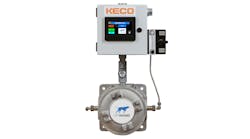About a year ago I wrote about the accuracy and reliability of the measurement of carbon dioxide (CO2) in the air. Of the received letters, one group argued that NASA's measurements are wrong and global warming does not exist and repeated the usual "denialist" silliness. The other group accepted the findings of the scientific community, and asked serious and interesting questions, such as: why does CO2 rise, when it's heavier than air? Why is CO2 the critical greenhouse gas, when there is much more water vapor in the air? Or, why can't a passive CO2 sensor operate at night? I'll answer both group of questions, naturally, within the space limitations of this short column.
Before coming to the questions, let me just say a few words about the scale of what we're doing to the planet. Sixty-five million years ago was the last time when the Earth was this warm. At that time, a meteorite impact in the Yucatan wiped out the dinosaurs and most other life forms and the Earth’s temperature spiked 5 °C. Current era global warming has reached 1 °C.
What are we doing? The daily per capita CO2 emission of each U.S. resident is 10 kg. To obtain each kWh of electricity, we emit 0.5 kg, and when driving, we release 0.25 kg per mile. One of our small (500 MW) "clean coal" power plants emits 100 tons of CO2 per hour. We're just beginning to see the first consequences (which affect the climate because the mass of the atmosphere is more than 1,000 times smaller than that of the oceans), but I will stop here, and get back to answering the questions, those of the denialists first.
From the denialist camp
The denialists question if global warming is occurring at all, and if it does, they question if it's caused by human activity. They contend that there could be other causes of the warming, such as an increase in the amount of geothermal heat coming from inside the planet, a decrease in the distance between our planet and the sun, or an increase in the solar radiation coming from the sun. Let's look at each.
- An increase in the amount of geothermal heat coming from inside the planet.The total geothermal power of the Earth varies between 33.2 and 44 terawatts (TW). The amount of heat required to heat only the oceans at the rate at which they're presently warming requires a heating power of 253 TW. Therefore, if the total geothermal heat is 44 TW, it can't cause 253 TW of heating.
- The distance between our planet and the sun has decreased as the Earth travels on its orbit around the sun. First, according to the Milankocich cycle effects, the period of eccentricity of the Earth's orbit around the sun (from circular to oval and back) is roughly 100,000 years. Second, the orientation of the Earth’s axis does not always point to the North Star, but cycles slightly off-center and returns to its original position every 26,000 years. Third, the angle at which Earth’s axis is tilted (between 22.1 and 24.5 degrees) and is responsible for our seasons, has a cycle period of 41,000 years. Clearly, the Milankovitch cycles can't cause a temperature rise that's occurring thousands of times faster.
- Solar radiation coming from the sun is increasing. During the last 80 years, the sun has been under continuous observation and its heat output has not increased, but stayed at 342 W/m². If anything, it's decreased slightly. Also, if that was the case, a larger portion would be absorbed during the day followed by a smaller portion at night. Yet, the portion of energy reflected back into space is the same day and night. Therefore, whatever is warming the Earth operates day and night, which rules out any heat source functioning only during the day. Therefore, the only possible explanation of the temperature rise is the increasing concentration of greenhouse gases that's causing the Earth to absorb more heat and radiate less back out into space.
Now to the “good” questions. The first is: "Why is CO2 uprising into the troposphere when it's heavier than air?" I could answer by saying, "Go fly a kite!" Not because I wanted to be rude, but to remind the questioner that the kite is also heavier than air and still flies. Actually, if the Earth was stationary then the atmosphere would, in time, separate into layers. Radon, the heaviest gas, would be at the bottom and the lightest gas (hydrogen) would be at the top. Thankfully this doesn’t happen or we’d all be breathing in radon—a toxic, radioactive gas.
Fortunately, our planet is wisely designed, it rotates and the resulting friction of the Earth's surface, plus the Coriolis force and the temperature and pressure differences move the air and the resulting wind causes diffusion that distributes the CO2 fairly evenly through the troposphere (lower atmosphere), and it even reaches the middle atmosphere (10-100 km), where its concentration is still fairly high (100 ppm), while at that height there's little or no water vapor.
Water vapor's greenhouse effect
Another question was, "Since water vapor is a greenhouse gas, don't changes in its concentration contribute to global warming?"
Unit for unit, water vapor is an abundant but weak greenhouse gas. CO2 causes about eight times as much warming as water vapor, methane causes about 200 times as much, and nitrous oxide about 2,500 times. The lifetime of H2O in the atmosphere is about two weeks, while CO2 remains in the atmosphere for decades to centuries. As to your question, there are two answers to it because the answer is different when the planet’s temperature is stationary and when it's warming!
Water vapor accounts for between 36% and 66% of the greenhouse effect when the sky is clear, and accounts for between 66% and 85% when it's cloudy. If the planet is at a constant temperature, then humidity remains approximately constant. This means the same amount of precipitation occurs over land when the air cools as evaporates over the oceans when they warm. Therefore, this constant humidity water cycle does not contribute to global warming.
However, when an increase in greenhouse gas concentration causes the planet's temperature to rise, the above described evaporation and condensation cycle is interrupted. A positive feedback loop is created because that warmer air can now carry more water vapor. So, increasing temperatures increase the water vapor in the atmosphere resulting in further warming.
For example, if the CO2 concentration rises to 560 ppmv from the pre-industrial 280 ppmv, the water vapor is estimated to add another degree Celsius to the global temperature. Hopefully and eventually, other processes will offset this positive feedback cycle, and stabilize the global temperature at a new (higher temperature) equilibrium, preventing the complete loss of Earth's water, through a Venus-like runaway greenhouse effect.
Figure 1: CO2 is measured at slightly over 2 microns, and while CO2 is highly absorbing, H2O is not. Unit for unit, water vapor is an abundant but weak greenhouse gas. CO2 causes about eight times as much warming as water vapor.
The last question: "Why can atmospheric CO2 measurements only be done in the daytime?" is an easy one.
CO2 is measured in the infrared range, at a wavelength of slightly over 2 microns, where water vapor interference is minimum (Figure 1). If NASA's pulsed, integrated path differential absorption (IPDA) sensor is used, pulses of both high- and low-absorption wavelengths are aimed at a hard target. The difference between the return signals correlates to the average amount of CO2 in the column between the detector and the target. This instrument can be used both during the day and at night.
You're right that NASA’s recently launched Orbiting Carbon Observatory works by observing the CO2 effect on sunlight. This technique isn't limited to a fixed target, but can make measurements at all locations (different altitudes etc). The key limitation of such passive measurements is they can only operate in daylight, so one can't measure, for example, respiration at night or at high latitudes, including the poles, where in the winter, there's no sunlight at all.







